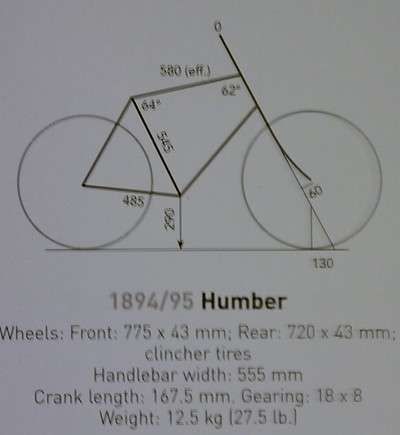Paris-Roubaix head-tube length record?
This year Cervelo overhauled its road bike geometry, merging the previous R and RS series into a single unified R. I plot head tube angle versus reach for 2010 and 2011 series: the 2011 R series goes from R-like at small sizes up to RS-like in large sizes.

On Sunday, Garmin-Cervelo's Johan Van Summeren produced an epic win at Paris-Roubaix riding his modified "R3". Johan's a tall guy: reportedly 2 meters in height, and rides the largest-size Cervelo. From the plot you can see this bike has a 22.5 cm head tube, 2 cm longer than the comparable bike from last year. And you can see every cm of this length in photos of Johan's bike, borrowed from VeloNews:


Impressive. Johan is at the limit of the frame's geometry with a slammed -17 degree stem (of course he could have used a retrograde stem to get even lower, but this is generally considered undesirable). This seems to support Cervelo's geometry.
But it got me thinking: is this the longest head tube ever to win in Paris-Roubaix's prestigious 106-year history?
The first Paris-Roubaix was held in 1896, won by Joseph Fischer on a bike which would look very much at place in the streets of San Francisco (Wikipedia photo):

Lacking any web pages with geometry charts for his bike, I need to estimate the head tube length myself. For that I need a length reference. Usually for this purpose I use wheel diameter in the direction of interest. The isuse is, however, that wheel diameter was not yet standardized in 1896.
As luck has it, I have Jan Heine's excellent The History of the Competition Bicycle and that has geometry measurements for an 1895-1896 Humber bicycle. Here's a poor photo of the diagram of the bike:

The front wheel is slightly larger than the rear on this one, something not evident in the photo of Josef's rig. I have a few candidate reference lengths I can use: for example the bottom bracket height or the chain stays. The result? Fairly close: it could go either way. I think Josef's head tube is longer than Johan's, but I'm not sure.
Certainly by the era of Louis Trousselier, the 1905 winner, riders had begun to adapt more aggressive positions and head tubes were shrinking.

Riders tend to run bars lower than they did in the mid-20th century, since riders previously used the drops more, the hoods less, than standard practice today. There was also a tendency to ride with the arms further forward (more stretched out). So if there was a rider of Johan's height who's won it before, that rider may well win the "prize".

On Sunday, Garmin-Cervelo's Johan Van Summeren produced an epic win at Paris-Roubaix riding his modified "R3". Johan's a tall guy: reportedly 2 meters in height, and rides the largest-size Cervelo. From the plot you can see this bike has a 22.5 cm head tube, 2 cm longer than the comparable bike from last year. And you can see every cm of this length in photos of Johan's bike, borrowed from VeloNews:


Impressive. Johan is at the limit of the frame's geometry with a slammed -17 degree stem (of course he could have used a retrograde stem to get even lower, but this is generally considered undesirable). This seems to support Cervelo's geometry.
But it got me thinking: is this the longest head tube ever to win in Paris-Roubaix's prestigious 106-year history?
The first Paris-Roubaix was held in 1896, won by Joseph Fischer on a bike which would look very much at place in the streets of San Francisco (Wikipedia photo):

Lacking any web pages with geometry charts for his bike, I need to estimate the head tube length myself. For that I need a length reference. Usually for this purpose I use wheel diameter in the direction of interest. The isuse is, however, that wheel diameter was not yet standardized in 1896.
As luck has it, I have Jan Heine's excellent The History of the Competition Bicycle and that has geometry measurements for an 1895-1896 Humber bicycle. Here's a poor photo of the diagram of the bike:

The front wheel is slightly larger than the rear on this one, something not evident in the photo of Josef's rig. I have a few candidate reference lengths I can use: for example the bottom bracket height or the chain stays. The result? Fairly close: it could go either way. I think Josef's head tube is longer than Johan's, but I'm not sure.
Certainly by the era of Louis Trousselier, the 1905 winner, riders had begun to adapt more aggressive positions and head tubes were shrinking.

Riders tend to run bars lower than they did in the mid-20th century, since riders previously used the drops more, the hoods less, than standard practice today. There was also a tendency to ride with the arms further forward (more stretched out). So if there was a rider of Johan's height who's won it before, that rider may well win the "prize".

Comments
"It's great, I just need a -17 140 to make the bike fit."
Another parameter might be the angle of the hands to the steering axis, whcih depends on the ratio of the bar width to the sum of the stem length and bar reach. Consider:
46 cm bars, 14 cm stem, 12 cm reach: ratio = 23 / 13
This is very close to 38 cm bars, 9.5 cm stem, 12 cm each.
So 14 for a large bike seems reasonable. Only issue is if you wanted to mount clip-on aero bars, that would be tricker, as hard to lower the bars for this purpose, assuming you'd want to do so.